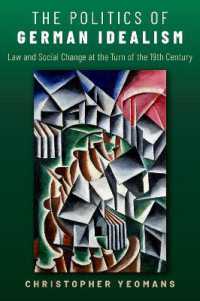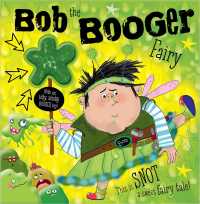Full Description
Inside the Invisible provides the first examination of the work of Turner Prize-winning Black British artist and curator Professor Lubaina Himid CBE. This comprehensive volume breaks new ground by theorizing her development of an alternative visual and textual language within which to do justice to the hidden histories and untold stories of Black women, children, and men bought and sold into transatlantic slavery. For Himid, the act of forgetting within official sites of memory is indivisible from the art of remembering within an African diasporic art historical tradition. She interrogates the widespread distortion and even wholesale erasure of Black bodies and souls subjected to dehumanizing stereotypes and grotesque caricatures within western imaginaries and dominant iconographic traditions over the centuries. Creating bodies of work in which she comes to grips with the physical and psychological realities of iconic and anonymous African diasporic individuals as living breathing human beings rather than as objectified types, she bears witness not only to tragedy but to triumph. A self-appointed researcher, historian, and storyteller as well as an artist, she succeeds in seeing "inside the invisible" regarding untold narratives of Black agency and artistry by mining national archives, listening to oral stories, acknowledging art-making traditions, and revisiting autobiographical testimonies.
Contents
List of Illustrations
Acknowledgements
Foreword by Marlene Smith
Introduction: Making Black Histories, Stories, and Memories Visible
I - 'Gathering and Reusing' by Lubaina Himid
Part 1: Visualising the 'Politics of Representation'
Chapter 1: 'Humour, fury, celebration, and optimism': A Politics of Protest and Cut-Out Men (1981-85)
Chapter 2: 'Rituals of reclaiming lost artefacts, refusing oppression and looking for ancestors' in Heroes and Heroines (1984)
Chapter 3: 'They who document / paint the History hold the Power': Retelling, Reimagining and Recreating New Narratives of Black Heroism in Toussaint I (1988) and Toussaint II (2002)
II - 'Telling Invisible Stories' by Lubaina Himid
Part 2: Resistance, Reclamation and Revolutionary History Painting
Chapter 4: No more 'Silent Victims': Agency, Authority and Artistry in the 'Black Woman's Story' in Revenge (1992)
Chapter 5: 'Lost hope, abandoned lives, decimated civilisations': Sites of 'Cultural Struggle' in Beach House (1995)
Chapter 6: 'Safety and danger and how to tell the difference': Suffering, Struggle and Survival in Plan B (1999)
III - 'Return to the Operatic' by Lubaina Himid
Part 3: Past, Present and Future Artistry, Activism and Agency
Chapter 7: Imaging and Imagining 'Lost Lives of the Black Diaspora' in Venetian Maps (1997)
Chapter 8: Reimaging and Reimagining an Absent-Presence in Cotton.com (2003)
Chapter 9: 'The Slave Servant': Guerrilla Memorialisation and Multi-accented Performances in Naming the Money (2004)
Chapter 10: 'Intervention, Mapping and Excavation': White Caricatures versus Black Dehumanisation in Swallow Hard: The Lancaster Dinner Service (2007)
IV - 'Painting over the British to reveal the British' by Lubaina Himid
Part 4: Imagining 'the ghosts and the traces'
Chapter 11: Tracing 'The living/ the dead/ the ancestors' in London and Paris Guidebooks (2009)
Chapter 12: Mapping Space, Debating Place: Jelly Mould Pavilions (2010) and Official Sites and Sights of Slavery and Memory
Chapter 13: 'The "Ghost" of it all': Tragedy, Trauma and a 'People There and Not There' in Le Rodeur (2016)
V - 'Working on Paper' by Lubaina Himid
'It's All about Action': An Interview with Lubaina Himid by Hannah Durkin
Conclusion: 'Lives Depend on Accurate Histories'
Bibliography








